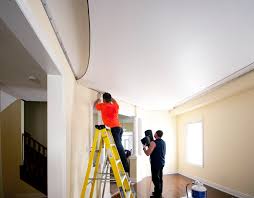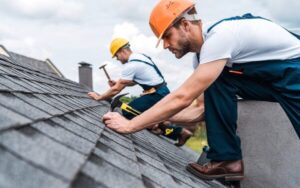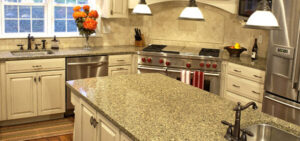Some homeowners swear by asphalt shingles, others hate them, but no one can ignore them. One of the reasons for it might be the source and nature of asphalt. While it is a by-product of crude oil refinement process, it is also non-reactive and durable in its solid form. They contain the remains of ancient plants and animals that have been under tremendous pressure for millions of years under the earth. People extract asphalt or bitumen from tar pits that have been around for hundreds and thousands of years. They are the same viscous black substance that swallows vehicles and spaceships in tons of movies and TV series (Lost in Space, anyone?). It is naturally water-resistant, and that makes it a favorite of the construction companies of the 21st century.
How has asphalt become the king of all roofing materials?
Slate was the popular material of choice for roofers and homeowners up until the last century. However, the problem of their weight, cost and the rusting nails became too prominent to ignore. That is when the world found its next roofing favorite. Since the early 20th century people started choosing asphalt roof shingles over their slate counterparts to overcome their weight, cost, and rust problems. The skyrocketing demand and advancing technology gave rise to two modern versions – fiberglass and organic shingles. These are variants of asphalt shingles, but their core components have different sources and varying durability. Understandably, their purchasing costs and installation expenses are also different. Organic ones come from recycled wood, cardboard, and paper. The fiberglass shingles use fiberglass and urea-formaldehyde resin to make it extra waterproof.
This is usually where homeowners begin to ask more about their roofing shingle options. These asphalt shingles come in a wide array of structures and color options. They fit Victorian architecture, Spanish architecture, and minimal modern ones without the need for the slightest modifications. While there are several other types of roofing materials available, most homeowners want asphalt shingles for their roofs. They give unmatchable durability and value to these homes, in terms of longevity and real estate valuations. They are durable, and they withstand a vast array of natural and human-made calamities. As a result, even the roofers who care about their reputation prefer asphalt shingles since they last long and enables the roofers to get excellent reviews.
What are the different types of asphalt shingles you should check out before investing in one?
Simply speaking asphalt shingles are small rectangular units that include a base mat, back surfacing, granules, and asphalt. They have been around for decades, but since 1980 they have been the uncontested favorite of the contractors and property owners alike. They are fire-retardant, waterproof, environmentally friendly and energy saving. Asphalt roofing is all the best features of a roof rolled into one! Apart from the stellar features, these come in four distinct variants.
Right now, there are four types of asphalt roofing shingles you need to know about –
- Three-tab shingles
These are affordable, and their installation is straightforward as well. The three-tab shingles are inexpensive. Many house owners prefer it over tiles since they look pleasing and shingles save a few pretty bucks as well.
- Architectural shingles
They are the dimensional variants. Architectural shingles are the most popular variety of shingles in the house renovation market. These are not exuberantly costly, yet the pack durability with style. They impart a three-dimensional aesthetic look to the roof and the house.
- Interlocking style
Asphalt shingles come in various styles, and interlocking shingle is one of them. They are instrumental in regions with high wind speed. Moreover, they can withstand high rain, sudden storms, and hail. If you live in an area that experiences sudden changes in weather and fast wind, you might want to consider the interlocking shingles. They might be expensive, but they also have an impressive lifespan.
- Large shingles
The large format shingles are slab-type structures that do not have tabs. They look like the old-school slate roofs. So, if you have an 18th century-inspired architecture or a late 19th-century construction, you can try going with these large format shingles that offer the grand slate roof look.
Asphalt shingles can be an upgrade from any roofing style and material
If you are worried about aesthetics, do not be! Asphalt is extremely customizable, and it is entirely possible to find shingle options that suit your house design. Laminated asphalt shingles impart the elegance of cedar shakes and slate to your roof. If you want to reinvent the personality of your home and find a high paying buyer in the future, you should look for dimensional shingles. The architectural shingles have a three-dimensional look about them. It is challenging for the best realtor to distinguish them from expensive wood shakes from afar.
In case you have always had a cedar shake roof, and you need to upgrade to a budget-friendly, but durable material, you should give architectural asphalt shingles a try. In the meantime, you can also check out the synthetic slate roofing options. Many modern roofers can install these new-age materials to give your home that million-dollar roof!
A few final points about asphalt roofing that will change your mind
Remember when we said that asphalt roofing could give your home that million-dollar look? Well, we should have mentioned that it does not cost a million dollars for achieving that look. Firstly, the installation costs of asphalt shingles are much lower than that of tiles and slate. Secondly, their maintenance costs are also significantly low. Thirdly, most of the modern designs come with energy star certification. Therefore, they are capable of saving over 15% of the total energy consumption in your house. They can not only keep your indoor environment cooler during the summer, but they can also trap the heat and keep the indoors more comfortable during the winter. Considering the expense and savings involved with asphalt roofing, you could it is a win-win situation. Oh, did we mention? Using energy star certified products could also help you save up on homeowner’s taxes.
Author Bio: Karen Anthony is a creative Home Decor Expert. She loves to share her creative knowledge of Home Improvement with her clients & friends. She is passionate about trending skills for Home Improvement.


















Be First to Comment